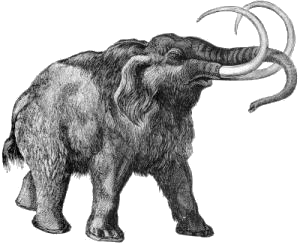Definify.com
Webster 1913 Edition
Mammoth
Mam′moth
(măm′mŏth)
, Noun.
[Russ.
mâmont
, mámant
, fr. Tartar mamma
the earth. Certain Tartar races, the Tungooses and Yakoots, believed that the mammoth worked its way in the earth like a mole.] (Zool.)
An extinct, hairy, maned elephant (
Mammuthus primigenius
formerly Elephas primigenius
), of enormous size, remains of which are found in the northern parts of both continents. The last of the race, in Europe, were coeval with prehistoric man. ☞ Several specimens have been found in Siberia preserved entire, with the flesh and hair remaining. They were imbedded in the ice cliffs at a remote period, and became exposed by the melting of the ice.
Mam′moth
(măm′mŏth)
, Adj.
Resembling the mammoth in size; very large; gigantic;
as, a
. mammoth
oxWebster 1828 Edition
Mammoth
MAM'MOTH
,Noun.
Definition 2025
mammoth
mammoth
English

A mammoth
Noun
mammoth (plural mammoths)
- Any species of the extinct genus Mammuthus, of large, usually hairy, elephant-like mammals with long curved tusks and an inclined back, which became extinct with the last retreat of ice age glaciers during the late Pleistocene period, and are known from fossils, frozen carcasses, and Paleolithic cave paintings found in North America and Eurasia.
- 1618, Richard James, “The Implications of James's Maimanto”, in Robert Auty, I. P. Foote, editor, Oxford Slavonic Papers. New Series., volume 9, Clarendon Press, published 1976, Dictionariolum Russico-Anglicum, page 103:
- Maimanto, as they say a sea elephant which is never seene, but accordinge to the Samuites he workes himselfe under grownde and so they finde his teeth or homes or bones in Pechore and Nova Zemla of which they […]
- 1698, Heinrich Wilhelm Ludolf, Sir James Augustus Henry Murray, Sir William Alexander Craigie, Charles Talbut Onions, editor, A New English dictionary on historical principles: founded mainly on the materials collected by the Philological Society., volume 6, Oxford: Clarendon Press, published 1908, A. Brand's Emb. Muscovy into China, page 98:
- The Mammotovoy, which is dug out of the Earth in Siberia.
- 1706, Evert Ysbrants Ides, “An Account of Elephants Teeth and Bones, found under Ground”, in The Philosophical Transactions of the Royal Society of London, from Their Commencement in 1665 to the Year 1800., volume 7, London: C. and R. Baldwin, published 1809, Three Years Travels from Moscow Over-land to China: Thro' Great Ustiga, Siriania, Permia, Sibiria, Daour, Great Tartary, Etc. to Peking ; Containing an Exact and Particular Description of the Extent and Limits of Those Countries, and the Customs of the Barbarous Inhabitants; with Reference to Their Religion, Government, Marriages, Daily Imployments, Habits, Habitations, Diet Death, Funerals etc. to which is Annex'd an Accurat Description of China, Done Originally by a Chinese Author., page 243:
- The old Siberian Russians affirm that the Mammuth is very like the Elephant.
-
- (obsolete) A mastodon.
- 1812, Samuel Fothergill and William Royston, “Half-yearly View of the Progress of Medicine”, in The Medical and Physical Journal, volume 27, London: Richard Phillips, page 24:
- Many of our readers will remember the skeleton of the American mammoth, now the Mastodonton, being exhibited in London by Mr. Rembrandt Peale.
-
- (figuratively) Something very large of its kind.
- 1802, Richard Hopwood Thornton, Louise Wardell Hanley, editor, An American Glossary: Being an Attempt to Illustrate Certain Americanisms Upon Historical Principles, volume 2, Philadelphia: J. B. Lippincott Company, published 1912, page 571:
- The last load, as we Yankees say, was a "Mammoth": […] producing an aggregate of nearly twelve cords.
-
Translations
elephant-like mammal
|
|
Adjective
mammoth (comparative more mammoth, superlative most mammoth)
- Comparable to a mammoth in its size; very large, huge, gigantic.
- 1801, Thomas Jefferson, Julian Parks Boyd, editor, The papers of Thomas Jefferson: 1 August to 30 November 1801, volume 35, Princeton University Press, published 2009, ISBN 0691137730, page 479:
- I recieved from the persons to whom the inclosed is directed, a present of a quarter of a Mammoth-veal which at 115. days old weighed 438. lb.
- 1802, Richard Hopwood Thornton, Louise Wardell Hanley, editor, An American Glossary: Being an Attempt to Illustrate Certain Americanisms Upon Historical Principles, volume 2, Philadelphia: J. B. Lippincott Company, published 1912, page 571:
- A baker in this city offers Mammoth bread for sale. We suppose that his gigantic loaves were baked at a Salt Lick, and perhaps […]
- 1898, Guy Wetmore Carryl, The Arrogant Frog and the Superior Bull, in Fables for the Frivolous (With Apologies to La Fontaine),
- “Ha! ha!” he proudly cried, “a fig / For this, your mammoth torso! / Just watch me while I grow as big / As you—or even more so!”
-
Derived terms
terms derived from mammoth
|
|
|
Synonyms
Translations
very large
|
|